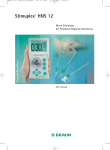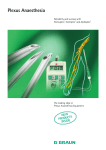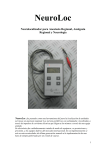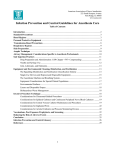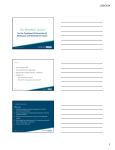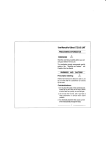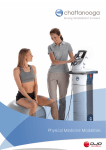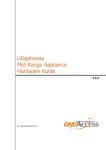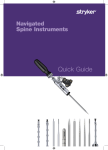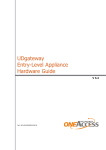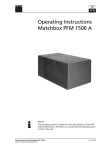Download Stimuplex® HNS 11 - Erfaringsregistrering
Transcript
Stimuplex® HNS 11 Nerve Stimulator for Regional Anaesthesia, Regional Analgesia, Neurology User manual Manufacturer: Distributor: Stockert GmbH Bötzinger Straße 72 D-79111 Freiburg Germany B. Braun Melsungen AG P.O. Box 11 20 D-34209 Melsungen Tel. (0 56 61) 71-0 Fax (0 56 61) 71-38 11 Contents Page Checks before start-up ................................................................................................................................................ 4 Technical description ..................................................................................................................................................... 6 Operating the nerve stimulator .......................................................................................................................... 7 Switching on / switching off .................................................................................................................................................. 7 Selecting the pulse frequency ............................................................................................................................................... 7 Selecting the pulse width ........................................................................................................................................................ 7 Selecting the current range .................................................................................................................................................... 8 Checking the battery voltage ................................................................................................................................................. 8 Selecting the current display mode .................................................................................................................................... 8 The LED displays .................................................................................................................................................................. 9 Current display mode ................................................................................................................................................................. 9 Current adjustment range ....................................................................................................................................................... 9 Pulse width ...................................................................................................................................................................................... 9 Pulse frequency ............................................................................................................................................................................. 9 Pulse LED display .......................................................................................................................................................................... 10 The LCD display .................................................................................................................................................................... 10 The tone ........................................................................................................................................................................................ 11 Initial set up, maintenance and general advice ................................................................................. 11 Testing the Stimuplex® HNS 11 before an application ............................................................................................... 11 Special technical features ....................................................................................................................................................... 12 Technical data ................................................................................................................................................................................ 12 Battery ............................................................................................................................................................................................... 13 Cleaning and disinfecting the Stimuplex® HNS 11 ...................................................................................................... 14 Maintenance and safety checks ........................................................................................................................................... 14 Safety checks / Local law restricts .......................................................................................................................... 15 Caution, Notice ............................................................................................................................................................................. 16 Safety information ...................................................................................................................................................................... 17 Error messages ............................................................................................................................................................................... 17 Instruments and accessories .................................................................................................................................................. 18 Stimuplex® HNS 11 and Accessories, Stimuplex® and Contiplex® needles ............. 18 Peripheral electrical nerve stimulation ...................................................................................................... 20 Performing PNS with the Stimuplex® HNS 11 and the Stimuplex® needles ........ 21 Literature .................................................................................................................................................................................... 23 Appendices A to D ............................................................................................................................................................ 24 Checks before start-up The Stimuplex® HNS 11 is a class lla medical device according to Council Directive 93/42/EEC. An item of medical equipment may only be put into operation after the supplier has subjected the equipment to a function test on site and has instructed the person responsible for operating the equipment in the use of the equipment with the aid of the user manual. Before putting the Stimuplex® HNS 11 into operation, carry out the following tests. 1. Turn the control knob clockwise out of the O position to switch on the Stimuplex® HNS 11. A brief click signals that this has taken place. At this instant, the devices automatically starts a self-test. This includes switching on all segments of the LCD display as a visual check. When the self-test is completed, the stimulator immediately switches to its normal operating mode. The LEDs on the button panel indicate the operating conditions selected. To conserve power, these extinguish after 8 seconds. If no display appears when the Stimuplex® HNS 11 is switched on, change the battery immediately. (Refer to the ”Battery” section, p. 13). If the self-test detects a defective function, the corresponding error code will appear in the LCD display and the instrument will then be inoperative! (Refer to the ”Error messages” section). When the LEDs are switched off, they can be reactivated by pressing any button. This does not change the existing operating mode. The operating mode can only be changed when the LEDs are lit. 2. Carry out a visual inspection of the electrode cable. Damaged cables must not be used. Connect the electrode cable to the front of the nerve stimulator. The plug connector configuration prevents wrong polarity connection. 4 5 In the operating mode, the LCD display shows the preselected stimulation current set on the controller between 0.00 and approx. 1.00 mA (in the 1 mA range) or from 0.00 to approx. 5.00 (in the 5 mA range). In the operating mode, the Stimuplex® HNS 11 shows the stimulation current actually flowing via the stimulation electrodes through the tissue. A ”+” sign on the LCD display signals this setting. The operating mode is switched by pressing the ”mA” button. 3. Select operating mode . Set the controller to 5 mA max. and try to get a connection with the insulated, black 2 mm male plug with a part of the red clamp. Compare – by briefly switching to operating mode – the measured value with the set value (actual value and set value). These two values must be the same – with shorted cables. Reset to 1 mA max. and compare these two values (see Measuring Accuracy in Appendix A, if neccessary). A ~ symbol appears next to the ▲ symbol in the LCD display (Display) and the pulsed LED display (orange light-emitting diode) blinks according to the stimulation frequence. A "+" sign appears in front of each measurement displayed. When a current is set at O, the orange LED starts to blink at 0.02 mA, when 1 mA max. is set, and at 0.10 mA when 5 mA max. is set. 4. When the stimulation cable is disconnected (when is set), +0.00 appears in the display and the ~ symbol disappears. The pulsed LED display is no longer lit. If the "BAT" symbol appears in the display, then the battery voltage is getting too low. Current application can be completed without a problem, but exchanging the battery afterwards should be considered. Press the "BAT" button to display the remaining battery voltage (in volts). When the battery voltage is approx. 6 volts, three horizontal dashes preceded by the "+" sign (or four dashes) appear in the display in addition to the "BAT" symbol. In this case, the stimulator shuts off automatically. To avoid having to abort a stimulator treatment, you should replace the 9 volt block battery as soon as the battery voltage drops to 6.5 volts. 5. To switch off the nerve stimulator, turn the control knob anticlockwise to position O. To conserve the battery always switch off the Stimuplex ® HNS 11 after use. If you do not use it for a long period of time, remove the battery to prevent battery leakage. Technical description 6. Refer to the Safety information section before using the Stimuplex® HNS 11 on a patient. Any instrument behaving abnormally must not be put into operation. Contact customer service. Electromedical equipment may only be repaired by the manufacturer or by an organization expressly authorized by the manufacturer. The Stimuplex® HNS 11 nerve stimulator is designed for reliable identification and location of nerves for local anaesthesia. It generates consistent square pulses with selectable frequency, selectable pulse width and continuously adjustable stimulation current. The range of adjustment of the pulse current from 0 to 5 mA peakto-peak can be reduced to 0 to 1 mA with the ”mA(max)” button. This 1 mA range allows precise adjustments for extremely thin and technically sophisticated needles. The stimulation frequency and the pulse width can be varied for different applications. The Stimuplex® HNS 11 nerve stimulator offers the facility for selecting a frequency of either 1 Hz or 2 Hz can be chosen together with pulse widths of 0.1 ms, 0.3 ms or 1.0 ms. When the Stimuplex® HNS 11 is switched off, all set parameters remain stored. As a visual and audible check, the ▲ symbol and a tick occur in time with the stimulation. Stimulation current flowing through the electrodes is signalled by the ~ symbol next to the ▲ and a + sign in front of the value for current in the display (in operating mode ). To conserve battery power, the LEDs on the button panel for the operating modes are switched off after approx. 8 seconds. They are reactivated by pressing any button. This does not change the operating mode setting, which can only be changed when the LEDs are lit. 6 Operating the nerve stimulator Switching on / switching off Turn the control knob clockwise out of the O position to switch on the Stimuplex® HNS 11. A brief click signals that this has taken place. At this instant, the device automatically starts a self-test. This includes switching on all segments of the LCD display as a visual check. When the self-test is completed, the nerve stimulator immediately switches to its normal operating mode. The LEDs on the button panel indicate the operating conditions selected (see below). To conserve power, these extinguish after 8 seconds. They light up again immediately when a button is pressed, but this does not change the operating mode. The operating mode can only be changed when the displays are lit. To switch off the nerve stimulator, turn the control knob anticlockwise to position O. Selecting the pulse frequency The selected setting is displayed and stored. You can change the setting by pressing the "Hz" button when the LED display is lit. The Stimuplex® HNS 11 nerve stimulator offers the facility of selecting a frequency of 1 Hz or 2 Hz (one or two pulses per second). Selecting the pulse width The pulse width can be set by pressing the ”ms” button. It is possible to set a stimulation of 0.1 ms, 0.3 ms or 1.0 ms. The selected setting is displayed and stored. Setting can be changed by pressing the "ms" button when the LED display is lit. 7 8 Selecting the current range The maximum current available can be selected by pressing the ”mA (max)” button. The Stimuplex® HNS 11 nerve stimulator offers a choice between a range up to 5 mA max. or up to 1 mA max. Values between 0.00 mA and 1.00 mA can be selected in the 1 mA range with the on/off control knob. This also allows precise adjustments to be made for extremely thin and technically sophisticated needles. For safety reasons, while a patient current is flowing, it is not possible to switch from the 1 mA range to the 5 mA range. If this is required, turn the control to 0.00 mA and then switch over. The selected current range is displayed and is stored until the ”mA (max)” button is pressed again. Checking the battery voltage Pressing the ”BAT” button will display the existing battery voltage on the LCD display. Pressing this button does not affect the Stimuplex® HNS 11 functions. All settings remain unchanged. Selecting the current display mode During operation of the nerve stimulator, the stimulation current is shown on the LCD display. Pressing the ”mA” button selects the current display mode: the stimulation current set (mA ) (displays set current) or the current actually flowing in the tissue (mA ) (displays actual current). In addition, a ”+” appears in front of the current on the LCD display in the case of the actual current display. If a current display mode is set (check this by switching to operating mode ) in the operating mode mA (actual current) and +0.00 appears in the display, then the possible source of the error could be: - the electrode cable is not connected to the device, the adhesive electrode is defective (possible too dry), the tissue resistance is very high, the connecting cables are defective. The measuring mode selected is displayed and is stored until the ”mA” button is pressed again. 9 The LED displays All LEDs directly assigned to the buttons are used to monitor the selected operating mode. Since LEDs require relatively high power, the Stimuplex® HNS 11 switches them off after 8 seconds (see p. 6 Section 7). The individual displays have the following significance: Current display mode The LCD display shows the stimulation current set ( ). The LCD display shows the stimulation current actually flowing ( ). In addition, a ”+” appears in front of the current displayed. Current adjustment range Setting range from 0.00 to 5.00 mA: Use the controller to dial a stimulation current up to 5 mA. The current is displayed in 0.02 mA digits. Setting range from 0.00 to 1.00 mA: Use the controller to dial a stimulation current up to 5 mA. The current is displayed in 0.01 mA digits. Pulse width Pulse width 1.0 ms: duration of stimulation pulse is 1.0 ms. Pulse width 0.3 ms: duration of stimulation pulse is 0.3 ms. Pulse width 0.1 ms: duration of stimulation pulse is 0.1 ms. Pulse frequency Pulse frequency 2 Hz (two pulses per second) Pulse frequency 1 Hz (one pulse per second) 10 Pulse LED display The small orange LED above the LCD display flashes according to the pulse frequency set (1 Hz: once per second; 2 Hz: twice per second) when current is flowing through the electrodes. At the same time, a louder tick can be heard. The LCD display According to the display mode selected, the LCD display shows the setting for, or the actually flowing stimulation current. The display is in mA. The ▲ symbol indicates the stimulation frequence. At the same time, there is a ticking sound in the same stimulation frequence. A ▲ symbol appears next to the ~ symbol in the same stimulation frequence when the stimulation current is flowing and the ticking sound gets louder. When the actual value display is selected, the LCD display additionally shows a "+" in front of the current displayed. Exceptions: 1. Pressing the ”BAT” button displays the battery voltage. 2. Equipment-related error functions produce the corresponding error code in the display (see p. 17). 3. The ”BAT” symbol in the display indicates that the battery must be exchanged soon. 4. When the battery voltage drops to approx. 6 volts or appears on the display. The stimulator switches off automatically when these signs appear. Display: The ”BAT” symbol indicates that the battery voltage is too low. (Refer to the ”Battery” section, p. 13) The tone Each generated pulse produces a tick. When a stimulation current flows to the electrodes (greater than 2% of the maximum stimulation adjustable), the tick becomes louder. If the stimulation current flowing exceeds the current set, then taking into account the measuring tolerance (see page 12 - Technical data - Measuring tolerance), the Stimuplex® HNS 11 institutes an error message consisting of several tone groups of rapid frequency (approx. 6 Hz). The device is no longer operational. Each time a button is pressed a short tone is produced of a different frequency as audible confirmation. A click confirms that the instrument has been switched on. Initial set up, maintenance, and general advice Testing the Stimuplex® HNS 11 before an application Switch on the Stimuplex® HNS 11 nerve stimulator by turning the control knob clockwise from position O. A short click confirms that switching on has taken place. When the self-test has been completed, the unit changes over immediately to the normal operating mode. You can now select the frequency, pulse width and current range according to the application required (see Section ”Operating the nerve stimulator”, p. 7). With the set current indication (mA ), do not connect both electrodes - check both current ranges (1 mA max and 5 mA max) up to maximum. Switch to actual current indication (mA ) - both mA ranges give a should reading of + 0.00 mA, independet from the set current. Connect the two electrodes (clip and plug) together: check the mA value in each case up to the maximum. All mA values have a ”+” sign in front of the display. As soon as current flows, the LED above the display flashes in time with the stimulation current. The ~ symbol appears next to the ▲ and the tick becomes louder. Set an actual current of approx. 0.30 mA and switch to set current (mA ): the two values should be the same (see Page 12 - Technical data - Measuring tolerance). If all adjustments have been found to be correct, your Stimuplex® HNS 11 is ready for application. 11 12 Special technical features The configuration of the electrode connection provides protection against a wrong polarity connection of the electrode cable. This new type of plug connection system ensures correct polarity of the electrodes at all times. A high stimulation voltage is associated with an unusually wide range of adjustment with extremely small stimulation electrodes. The Stimuplex® HNS 11 generates a negative, current-stabilized square pulse. In contrast to conventional instruments of this type, the pulse is shaped at both slopes by extremely fast active pulse drivers. An output amplifier specially designed for this application has an extraordinarily wide dynamic range and produces reproducible settings even below 0.1 mA. Use of the latest microcomputer technology has made it possible to integrate performance characteristics which until now could only be provided in large systems. For example: selection of current display mode, set and actual value display, display of battery charge, error messages. An internal quartz time base ensures precise pulse widths and frequencies. Technical data Type: Stimuplex® HNS 11 nerve stimulator Instrument type ................ BF Battery ................................. 9 V Power consumption ......... 3.3 mA Stimulation current ......... max. 5 mApp / 0 ⏲ - 12 k⏲ Stimulation voltage ........ max. 65 Vpp Stimulation frequency .... 1 Hz / 2 Hz Measuring tolerance ....... Adjustment control display =3% (set point) Flowing current display = 2% (actual value) based on set mA max values (5 mA or 1 mA) Weight ................................. 250 g Due to its high maximum output voltage the nerve stimulator covers a wide range of skin and needle impedance. This is especially important when using stimulation needles with an extremely small conductive area (pin point electrode tip) such as Stimuplex® D and Contiplex® D needles. 13 Battery The battery must be regularly checked for correct charge by pressing the ”BAT” button. While the button is pressed, the existing battery voltage appears on the LCD display. The battery should be replaced under 7 volts – as soon as the BAT symbol appears. When the battery voltage drops below 6 V, the nerve stimulator stops operating. Four horizontal lines and the BAT symbol appear in the LCD display. Change the battery. When the Stimuplex® HNS 11 nerve stimulator is not used for a long period of time, the battery must be removed to prevent leakage. Changing the battery The battery compartment is in the base of the nerve stimulator. Open the compartment by lightly pressing the OPEN symbol. At the same time, slide the cover in the direction of the arrow. Change the battery, ensuring correct polarity. After fitting the battery, slide the cover of the battery compartment back on again right up to the limit stop. Use only 9 V alkaline manganese batteries (e.g. VARTA 4022, DURACELL MN 1604). These will provide you with a greatly extended operating time and thus considerably more reliable function. Warning! If the battery is leaking, the Stimuplex® HNS 11 should no longer be operated for safety reasons. Acid penetrating the inside of the instrument can damage or impair essential circuitry. It must be returned to the manufacturer for correct cleaning and a safety check. 14 Cleaning and disinfecting the Stimuplex® HNS 11 Use only soft, damp cloths to clean and disinfect the Stimuplex® HNS 11 and the electrode cable. Water, soap or white spirits are especially suitable for this. Ensure that no moisture penetrates the Stimuplex® HNS 11. Use only wet disinfection, no spray disinfection! Avoid condensation! White spirit or commercially available methanol-free disinfectant in an ethyl alcohol base can be used for disinfection. Caution! The following substances must not be used: trichloroethylene, acetone, methyl ethyl ketone, benzene, methanol, cellulose thinner, 1-propanol and 2-propanol. Maintenance and safety checks Check the serviceable condition of the Stimuplex® HNS 11 and accessories on each occasion before use. A defective instrument must not be used. Electromedical equipment may only be repaired by the manufacturer or by an organization expressly authorized by the manufacturer. An order for repairs must be accompanied by a detailed description of the fault (acc. separate Technical Service Manual). 15 For usage of HNS 11 please refer to the individual local law restricts (eg. maintaining a logbook, etc.). In case of conducting safety checks on the device, please refer to the enclosed inspection sheet. 16 Caution Electromagnetic fields may interfere with the function of the nerve stimulator. Do not use the stimulator in the proximity of equipment which produces strong electromagnetic fields such as HF high frequency surgical equipment, micro wave equipment or cordless phones. Notice The cables of the nerve stimulator Stimuplex® HNS 11 should be positioned in such a way that they do not contact either the patient or other cables. All accessories have to be visually inspected at regular time intervals. The insulation of the cables must not exhibit any damage. Only original accessories from B. Braun labelled with the CE sign should be used. Regarding the disposal of the nerve stimulator and its accessories you should refer to the corresponding regulations in your country. Storage and shipping conditions: 0 – 50° C, up to 90 % relative humidity, non condensation. Warranty Stimuplex® HNS 11 is guaranteed for two years against defects in material and workmanship if the device is used in accordance with the operationg instructions. Wear and tear parts such as electrode cables, batteries, etc. are not covered by this warranty. In addition, relevant sections of our General Sales Conditions (Allgemeine Verkaufsbedingungen) apply particularly in chapter IV No. 8. 17 Safety information The nerve stimulator should not be used on patients with implanted electrical devices (e.g. cardiac pacemakers) without prior consultation with an appropriate medical specialist. Possible interference with the implanted devices by the stimulation current could represent a danger to the patient. The adhesive electrodes must not be applied in the area of injuries. The Stimuplex® HNS 11 nerve stimulator must not be used in areas where there is an explosion hazard. The Stimuplex® HNS 11 nerve stimulator must not be used close to microwave therapy equipment. The possible pick-up of radio frequency currents by the stimulation electrode could damage the nerves. The patient current should not drop below a specific value (please refer to p. 21 points 8 and 9). If the battery has leaked, the Stimuplex® HNS 11 must not continue to be operated for safety reasons. It must be returned to the manufacturer for correct cleaning. The same applies if any liquid soaks through! In the event of warning tone sequences (tone groups of approx. 6 Hz), the Stimuplex® HNS 11 must be switched off and returned to the manufacturer or distributor for repair. Error messages When the Stimuplex® HNS 11 nerve stimulator is switched on, it automatically carries out a self-test. If this detects a faulty function, the fault is shown on the corresponding error code on the LCD display. The Stimuplex® HNS 11 is then no longer operational. It must be returned to the manufacturer for repair. You should state the error code in the repair order. The following error codes are possible: - F1: - F2: - F3: Analogue data acquisition is faulty Error in the program Reference error in the analogue data acquisition system 18 Instruments and accessories The Stimuplex® HNS 11 nerve stimulator should only be operated with the accessories and instruments mentioned on page 13, 14, 18 and 19 of this user manual. Check the accessories and instruments for serviceable condition before every occasion of use and comply with the care and disinfection instructions supplied (p. 14). Stimuplex® HNS 11 and Accessories, Stimuplex® and Contiplex® needles Product discription Canula Ø x length Code number Sales unit Stimuplex® HNS 11 nerve stimulator – with electrode cable for Stimuplex® D-, Stimuplex® A- and Contiplex® D- needles 4892097 1 Knob for sterile handling Electrode cable for Stimuplex® D, Stimuplex® A and Contiplex® D needles Connection cable for Contiplex® A needles 4892283 4892070 1 1 4892925 1 0.5 x 35 mm 0.5 x 55 mm 0.6 x 40 mm 0.6 x 70 mm 0.7 x 50 mm 0.7 x 80 mm 0.7 x 120 mm 0.9 x 150 mm 4894103 4894111 4894120 4894138 4894146 4894154 4894162 4894170 25 25 25 25 25 25 25 25 0.7 x 40 mm 0.7 x 50 mm 0.7 x 80 mm 4894189 4894197 4894200 25 25 25 Stimuplex® D needles, 15° bevel D 25/035; 25 G x 11/3" D 25/055; 25 G x 2 1/8" D 26/040; 23 G x 11/2" D 26/070; 23 G x 23/4" D 27/050; 22 G x 2" D 27/080; 22 G x 31/8" D 27/120; 22 G x 4 3/4" D 29/150; 20 G x 6" Stimuplex® D needles 30° bevel D 17/040; 22 G x 11/2" D 17/050; 22 G x 2" D 17/080; 22 G x 31/8" 19 Product discription Canula Ø x length Code number Sales unit 0.55 x 25 mm 0.70 x 25 mm 0.70 x 50 mm 0.80 x 50 mm 0.80 x 100 mm 0.90 x 150 mm 4894251 4894539 4894502 4894375 4894260 4894278 25 25 25 25 25 25 1.3 x 55 mm 1.3 x 110 mm 4894219 4894294 25 25 D 18/055/C; 18 G x 21/8" 1.3 x 55 mm 4894227 25 Contiplex® D Catheter Set – with polyamide catheter 0.45 x 0.85 x 400 mm needle D 28/055/C; 18 G; 15° bevel needle D 18/055/C; 18 G; 30° bevel – with polyamide catheter 0.45 x 0.85 x 1000 mm needle D 28/110/C; 18 G; 15° bevel 1.3 x 55 mm 1.3 x 55 mm 4894235 4894243 10 10 1.3 x 55 mm 4894391 10 A 45/C; 18 G x 13/4" A 55/C; 18 G x 21/8" 1.3 x 45 mm 1.3 x 55 mm 4893611 4893643 25 25 Contiplex® A Catheter Set – with polyamide catheter 0.45 x 0.85 x 400 mm needle A 45/C; 18 G; 30° bevel needle A 55/C; 18 G; 30° bevel 1.3 x 45 mm 1.3 x 55 mm 4893603 4893638 10 10 Alphaplex® Catheter Set – with catheter 0.9 m x 1.25 m x 330 mm, – guide wire and Contiplex® D – D 28/055/C; 15° and 30° bevel Basic Set, 15° bevel Super Set, 15° bevel Basic Set, 30° bevel Super Set, 30° bevel 1.3 x 55 mm 1.3 x 55 mm 1.3 x 55 mm 1.3 x 55 mm U 1800 210 U 1800 200 U 1800 201 U 1800 203 10 10 10 10 Stimuplex® A needles, 30° bevel A 25; 24 G x 1" A 25; 22 G x 1" A 50; 22 G x 2" A 50; 21 G x 2" A 100; 21 G x 4" A 150; 20 G x 6" Contiplex® D needles, 15° bevel D 28/055/C; 18 G x 21/8" D 28/110/C; 18 G x 43/8" Contiplex® D needles, 30° bevel ® Contiplex A needles, 30° bevel Peripheral electrical nerve stimulation Principles By simplifying the accurate location of peripheral nerves, peripheral electrical nerve stimulation (PNS) facilitates the performance of nerve and plexus blocks increasing their safety and reliability. The old rule ”no paraesthesia - no anaesthesia” (1) loses its validity, because information from the patient concerning paraesthesia is eliminated, and the danger of a mechanical nerve lesion (8) is largely excluded. The principle consists of triggering depolarizations with electrical pulses at, but not within, the nerve, causing muscular contractions at the effector muscle or sensitive sensations in the distribution area. Paraesthesia due to direct contact of injection needles and nerve is consciously avoided. PNS does not replace the anatomical knowledge required for regional anaesthesia, rather it assumes accurate knowledge of the topography and the nerve distribution area. The various types of nerve fibre differ in regard to their sensitivity to electrical stimulation. The A-alpha motor fibres have the shortest chronaxia (50 - 100 µs). The fibres of pain sensation (A-delta and C-fibres) require a longer pulse (150 and 400 µs respectively) at minimum current. Mixed peripheral nerves can be localized with short pulses (0.1 ms) without triggering pain sensations. For pure sensory nerves, a longer pulse (0.3 or 1.0 ms) is recommended. When using unipolar needles (needles with an insulated needle shaft and a conductive tip), the current necessary to trigger muscular contractions (= pulse amplitude) correlates with the distance of the tip of the needle from the nerve: the lower the threshold current the more accurately is the nerve localized, and the shorter the onset and more reliable the success of the block (4). The shorter the electrical pulse (= pulse width), the faster is the rise in current to the nerve, and the clearer the discrimination as to whether the needle tip is sufficiently close to the nerve (2,5). The stimulation needle should always be connected to the negative pole because higher currents are required if the polarity is reversed (needle positive) (6). The geometry of the electrical current field is dependent on the geometry of the conductive tip of the stimulation needle. The smaller the emission site of the electrons at the tip of the needle, the higher is the current density at this point and the lower the threshold current when the nerve is exactly localized. The Stimuplex® HNS 11 stimulator has been designed according to the most modern aspects and the requirements which originate from the theory and practice of peripheral electrical nerve stimulation (3,6). It is provided with alarm systems necessary for the 20 21 early detection of technical faults which could endanger the patient and place the success of the anaesthesia in jeopardy. Performing PNS with the Stimuplex® HNS 11 and the Stimuplex® or Contiplex® needles 1. Check the Stimuplex® HNS 11. 2. Check the skin electrode (ECG adhesive electrode) (the conductive gel must not have dried) and apply it to a degreased area of skin which is not in the distribution area of the nerve to be blocked. 3. Carry out patient positioning, skin disinfection, and if necessary, local infiltration of the needle puncture site. 4. Connect the electrode cables to the stimulation needle (negative) and skin electrode (positive), switch on the Stimuplex® HNS 11 and set the mA controller current (mA ) to zero. After the automatic self-test of the stimulator, the ▲ symbol appears in the display in time with the stimulation pulse to indicate that it is ready to operate. Caution! A change to the stored parameters can only be made when the LEDs are lit. By pressing any button the LEDs will light up and indicate the value stored. To change press the appropriate button. 5. 6. 7. 8. Select pulse width (0.1 ms, 0.3 ms or 1.0 ms). Select pulse frequency (1 Hz or 2 Hz). Select amplitude range (1 mA max or 5 mA max.). Advance the Stimuplex® or Contiplex® needle through the skin and the subcutaneous tissue towards the nerve to be blocked. Set a current of approx. 0.30 mA (set value mA ) - the orange LED above the display flashes in time with the stimulation, the display shows a ~ next to the ▲ and a tick signals that current is flowing in the tissue. Then switch to actual current flowing value indicator (mA ) and check that the actual value corresponds to the set value (see p. 12 - Technical data, measuring tolerance). 22 If the two values coincide, the total resistance is acceptable (impedance test) and the electric circuit is satisfactory. If the actual value is less than the set value, this indicates that the electrical resistance in the external circuit is too high. The cause must be found e.g. adhesive electrode too dry, skin resistance too high, broken cable. After the impedance test, leave in the mA position (current flowing at the tip of the needle indicated and a + sign in front of the current displayed) until the block is successful. 9. Set an actual current of approx. 1 to 2 mA and advance the needle further until the first muscles supplied by contractions occur in the nerve sought. Then, while reducing the current, advance the needle to the nerve until the recommanded threshold current. (For values see, for example, literature references 4, 7). The threshold current to be achieved depends on the pulse width and the geometry of the conductive tip of the needle. Warning! When using Stimuplex® or Contiplex® needles, it must be noted that muscular contractions with a current of 0.2 to 0.5 mA and a stimulus duration of 0.1 ms - with a current of 0.05 to 0.2 mA and a stimulus duration of 1.0 ms - indicate satisfactory proximity to the nerve sought. Any further reduction in the ”threshold currents” may cause direct contact of the needle with the nerve, resulting in the danger of a mechanical nerve lesion. If needles from other manufacturers are used, the threshold currents may be much higher. You would have to work out these yourself. 10. After clearly visible muscular contractions are seen using the desired threshold current, inject local anaesthetic. The response to the electrical stimulation will reduce or disappear within a few seconds after an injection of 2 - 3 ml. If this effect is not definite, do not continue to search for the nerve at the same location. For safety reasons, a more peripheral site should be used. Literature Literature 1. Moore DC (1965), Regional block. A handbook for use in the clinical practice of medicine and surgery. Thomas, Springfield II. (4th ed.) 2. Ford DJ, Pither CE, Raj PP (1984), Electrical characteristics of peripheral nerve stimulators. Implications for nerve Iocalization. Reg Anesth 9:73. 3. Ford DJ, Pither CE, Raj PP (1984), Comparsion of insulated and uninsulated needles for locating peripheral nerves with a peripheral nerve stimulator. Anesth. analg. 63:925 4. Kaiser H, Niesel HC, Klimpel L (1988), Einfluss der Reizstromstärke der Nervestimulation auf Latenz und Erfolg der hinteren Ischiasdiskusblockade. Regional-Anaesthesie 11:92. 5. Kaiser H, Niesel HC, Hans V (1990), Grundlagen und Anforderungen der peripheren elektrischen Nervenstimulation. Regional-Anaesthesie 13:143 6. Kaiser H, Niesel HC, Hans V, Klimpel L (1990), Untersuchungen zur Funktion peripherer Nervenstimulation für die Durchführung von Nerven- und Plexusblockaden. Regional-Anaesthesie 13:172. 7. März P, (1990), Kann bei der elektrischen Nervenstimulation aus der Intensität der Muskelkontraktion auf den Abstand zum Nerven geschlossen werden? Regional-Anaesthesie 13:179. 8. Selander D, Edshage S, Wolff T (1979), Paraesthesiae or no paraesthesiae: nerve lesions after axillary block. Acta anaesthesiol. scand. 23:27. Further literature: Kaiser H, Die periphere Nervenstimulation In Niesel HC (dir.), Regionalanästhesie, Lokalanästhesie, Regionale Schmerztherapie. Thieme-Verlag Stuttgart New York (1994), 186-207. Prithvi Raj P (Editor), Clinical practice of regional anaesthesia. Churchill Livingstone New York (1991) Pinncock CA, Fischer HBJ, Jones RP, Peripheral nerve blockade. Churchill Livingstone New York (1996) Scott DB, Introduction to regional anaesthesia. Mediglobe Fribourg (1989) 23 24 Appendix A Stimulation current display in the mA range Patient current Measurement display Controller display Patient current Measurement display Controller display 0.00 mA 0.05 mA 0.10 mA 0.20 mA 0.30 mA 0.40 mA 0.60 mA 0.80 mA 1.00 mA 0.00 mA 0.05 mA ± 0.02 0.10 mA ± 0.02 0.20 mA ± 0.02 0.30 mA ± 0.02 0.40 mA ± 0.02 0.60 mA ± 0.02 0.80 mA ± 0.02 1.00 mA ± 0.02 0.00 mA 0.05 mA ± 0.03 0.10 mA ± 0.03 0.20 mA ± 0.03 0.30 mA ± 0.03 0.40 mA ± 0.03 0.60 mA ± 0.03 0.80 mA ± 0.03 1.00 mA ± 0.03 0.00 mA 0.50 mA 1.00 mA 1.50 mA 2.00 mA 3.00 mA 4.00 mA 5.00 mA 0.00 mA 0.50 mA ± 1.00 mA ± 1.50 mA ± 2.00 mA ± 3.00 mA ± 4.00 mA ± 5.00 mA ± 0.00 mA 0.50 mA ± 0.15 1.00 mA ± 0.15 1.50 mA ± 0.15 2.00 mA ± 0.15 3.00 mA ± 0.15 4.00 mA ± 0.15 5.00 mA ± 0.15 0.1 0.1 0.1 0.1 0.1 0.1 0.1 Appendix B Conversion table: Amplitude (mA) and pulse width (ms) to charge (nano-Coulomb, nC) Amplitude Pulse width mA ms 0.1 0.1 0.2 0.1 0.3 0.1 0.4 0.1 0.5 0.1 0.6 0.1 0.7 0.1 0.8 0.1 0.9 0.1 1.0 0.1 1.2 0.1 1.6 0.1 1.8 0.1 2.0 0.1 2.5 0.1 3.0 0.1 3.5 0.1 4.0 0.1 4.5 0.1 5.0 0.1 Charge nC 10 20 30 40 50 60 70 80 90 100 120 160 180 200 250 300 350 400 450 500 Pulse width ms 0.3 0.3 0.3 0.3 0.3 0.3 0.3 0.3 0.3 0.3 0.3 0.3 0.3 0.3 0.3 0.3 0.3 0.3 0.3 0.3 Charge nC 30 60 90 120 150 180 210 240 270 300 360 480 540 600 750 900 1050 1200 1350 1500 Pulse width ms 1.0 1.0 1.0 1.0 1.0 1.0 1.0 1.0 1.0 1.0 1.0 1.0 1.0 1.0 1.0 1.0 1.0 1.0 1.0 1.0 Charge nC 100 200 300 400 500 600 700 800 900 1000 1200 1600 1800 2000 2500 3000 3500 4000 4500 5000 25 Appendix C Appendix C Stimuplex® HNS 11 Nerve Stimulator Operating range Max. stimulation voltage [V] Operating range Battery voltage [V] Stimuplex® HNS 11 Nerve Stimulator Max. stimulation current as a function of tissue resistance Max. stimulation current [mA] Battery voltage [V] 26 Appendix D Current density Bare and insulated needles Stimulation current [mA] Stainless steel needle Bare, uncoated needles Plastic insulation Coated needles bevel uncoated Stimuplex® A Contiplex® A Distance from the nerve [mm] Stimuplex® D and Contiplex® D needles (DP: DE 3919666) Only 0.2 or 0.05 mA stimulation current required blunt 30° Stimulation current [mA] Fully insulated needle with bare tip Stimuplex® D Contiplex® D Distance from the nerve [mm] Threshold currents down to minimum 0.05 mA (with 1.0 ms pulse width) and minimum 0.2 mA (with 0.1 ms pulse width) allow reliable location of nerves. pointed 15° Caution: Federal (U. S. A.) law restricts this device to sale by or on the order of physicians. W. 01.08.01/7 Nr. 604 3895 hospital care B. Braun Melsungen AG P.O. Box 11 20 D-34209 Melsungen Tel (0 56 61) 71- 0 Fax (0 56 61) 71-38 11 www.bbraun.com




























